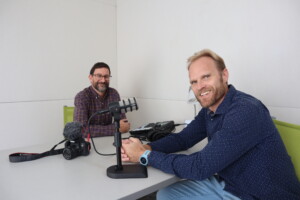Talk to the average person about “water shed management,” and you might get some blank stares.
But show them a photo essay of crops and unhealthy forests – along with an audio narration about how a local farmer copes with water scarcity in one of the driest places in North America – and you can almost see the lightbulb go off above their heads.
That’s the power of storytelling.

Tyler Dorholt and Jason Kohlbrenner in Digital Storytelling Studio
And it’s why ESF’s Digital Storytelling Studio (DSS) exists: to provide students with the digital tools and support to create and craft environmental and scientific stories in dynamic ways. When you bring science to life by sharing stories of real people and places through audio, photo, and video, it opens a new level of understanding and support.
“The Digital Storytelling Studio is coming up on its sixth year at ESF. We are only just now seeing how widely it can help impact the work of our students,” said Tyler Dorholt, coordinator of the Digital Storytelling Studio, and director of the Writing Program.
Case in point, three ESF undergraduate students were finalists in a national storytelling competition in Washington, D.C. last year. The Planet Forward StoryFest competition saw more than 140 entries from 30 schools in 20 states and three countries. More than 30 ESF students submitted entries – that’s more than any other school and incredible exposure for both the students and the College. While ESF’s finalists didn’t win, their multimedia stories called attention to problems and solutions related to climate change and protecting the planet.
Today, Dorholt oversees the studio with Jason Kohlbrenner, DSS Digital Support Specialist. In addition to teaching two courses on campus – The Art of Storytelling and the eponymous Digital Storytelling Studio – they mentor students as they work on their projects in the studio. The DSS is proud to have collaborative relationships with faculty in Environmental Studies, Landscape Architecture, Environmental Biology, Environmental Resources Engineering, and Sustainable Resources Management to incorporate digital media into their curriculum. The DSS also partners with student organizations such as the Environmental Studies Student Organization and the Photography Club.
“The DSS is available to anyone on campus, and we really want faculty and students to see the benefits of what we offer,” Kohlbrenner said. “If you haven’t been here before, we provide state-of-the-art high-definition monitors with the latest Adobe editing software. We have excellent video and photo equipment that can be rented out. This is a specialty space where students can work on high-end projects.”
Dorholt and Kohlbrenner also utilize the DSS to create their own stories for ESF. In October, they spent time in Newcomb, NY documenting the effects of severe flooding and interviewing ESF scientists such as Dr. Stacy McNulty ‘97, Associate Director of Research at the Newcomb campus. They’re thinking about using their footage to help create a documentary that illustrates the impact of climate change in the Adirondack region. Dorholt said they hope to continue to find ways to tell more stories about all the incredible work being done; as well as the challenges of making science clear and compelling.
“There is real value to telling stories,” Dorholt said.
He also said the stories students tell don’t need to be on the scale of a documentary – they could be as simple as creating a digital resume. “Every student who leaves ESF should have a short film about the project they feel best represents the work they did here. Not only could this help them stand out from their peers, but it could increase their chances of getting a meaningful job.”
Dorholt and Kohlbrenner have big ideas on how to grow the DSS and the passion to help make it happen. The work of students and research of faculty at ESF have never been more important; the DSS is prepared to help bring their complex stories to life through images, videos, and podcasts.


